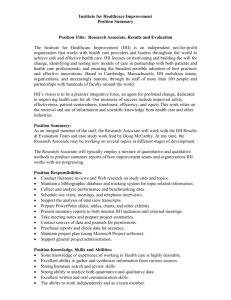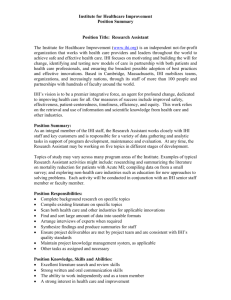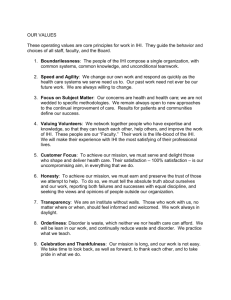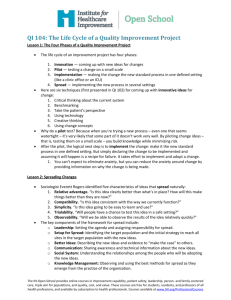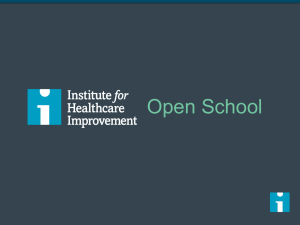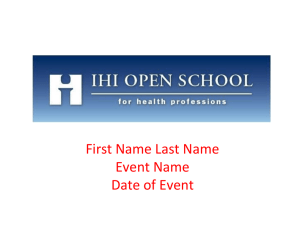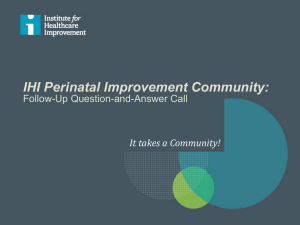IHI Open School Student Recruitment Presentation Transcript
advertisement
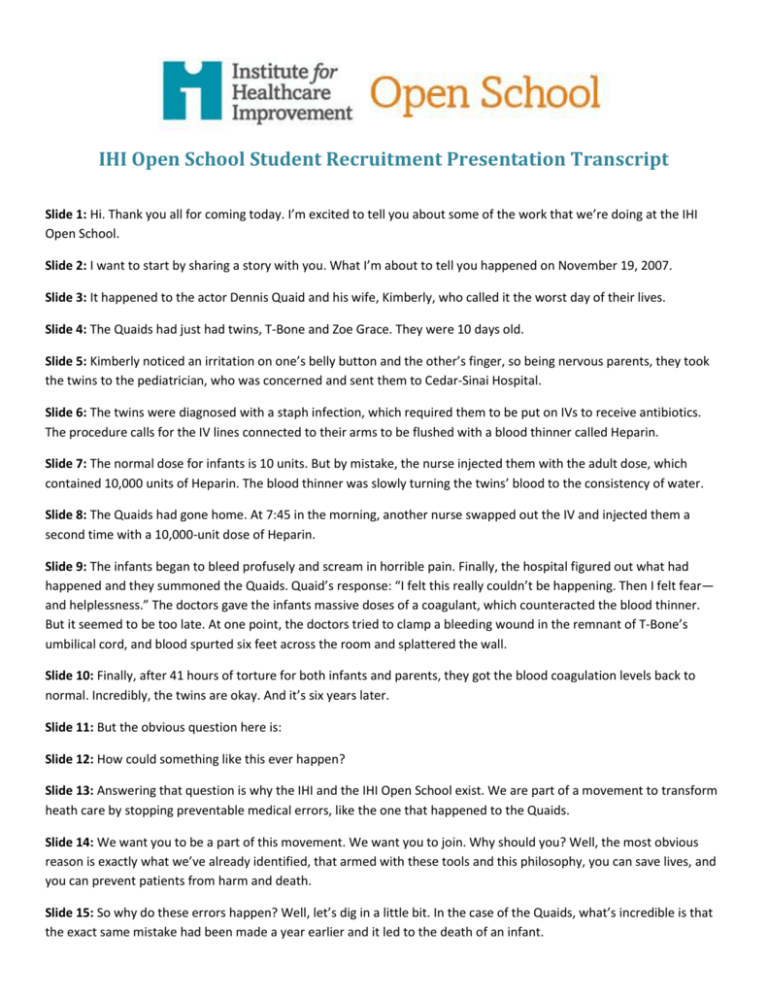
IHI Open School Student Recruitment Presentation Transcript Slide 1: Hi. Thank you all for coming today. I’m excited to tell you about some of the work that we’re doing at the IHI Open School. Slide 2: I want to start by sharing a story with you. What I’m about to tell you happened on November 19, 2007. Slide 3: It happened to the actor Dennis Quaid and his wife, Kimberly, who called it the worst day of their lives. Slide 4: The Quaids had just had twins, T-Bone and Zoe Grace. They were 10 days old. Slide 5: Kimberly noticed an irritation on one’s belly button and the other’s finger, so being nervous parents, they took the twins to the pediatrician, who was concerned and sent them to Cedar-Sinai Hospital. Slide 6: The twins were diagnosed with a staph infection, which required them to be put on IVs to receive antibiotics. The procedure calls for the IV lines connected to their arms to be flushed with a blood thinner called Heparin. Slide 7: The normal dose for infants is 10 units. But by mistake, the nurse injected them with the adult dose, which contained 10,000 units of Heparin. The blood thinner was slowly turning the twins’ blood to the consistency of water. Slide 8: The Quaids had gone home. At 7:45 in the morning, another nurse swapped out the IV and injected them a second time with a 10,000-unit dose of Heparin. Slide 9: The infants began to bleed profusely and scream in horrible pain. Finally, the hospital figured out what had happened and they summoned the Quaids. Quaid’s response: “I felt this really couldn’t be happening. Then I felt fear— and helplessness.” The doctors gave the infants massive doses of a coagulant, which counteracted the blood thinner. But it seemed to be too late. At one point, the doctors tried to clamp a bleeding wound in the remnant of T-Bone’s umbilical cord, and blood spurted six feet across the room and splattered the wall. Slide 10: Finally, after 41 hours of torture for both infants and parents, they got the blood coagulation levels back to normal. Incredibly, the twins are okay. And it’s six years later. Slide 11: But the obvious question here is: Slide 12: How could something like this ever happen? Slide 13: Answering that question is why the IHI and the IHI Open School exist. We are part of a movement to transform heath care by stopping preventable medical errors, like the one that happened to the Quaids. Slide 14: We want you to be a part of this movement. We want you to join. Why should you? Well, the most obvious reason is exactly what we’ve already identified, that armed with these tools and this philosophy, you can save lives, and you can prevent patients from harm and death. Slide 15: So why do these errors happen? Well, let’s dig in a little bit. In the case of the Quaids, what’s incredible is that the exact same mistake had been made a year earlier and it led to the death of an infant. Slide 16: And the mistake that was made was a simple one. You remember that I told you there was a 10,000-unit bottle of Heparin. Well that bottle had a dark blue label. And the 10-unit bottle that’s intended for neonatal usages, it has a light blue label. So from a certain angle in certain light, it can be hard to tell them apart. Slide 17: And that story tells you more about why we’re here today, that there’s this belief that the right systems make mistakes like this impossible. Here’s another example: Look at this prescription from a doctor. This is an actual prescription, and I want you to look at it and see if you can interpret what it says. There may be words that you think you can read, but my question is this: If your loved one depended on the prescription that was called for by this handwriting, would you trust them to it? Would you trust their ability to comprehend it? Slide 18: In some hospitals, wait times in emergency rooms have become a major source of error. In several cases, patients have literally died of heart attacks because they were waiting for four hours before they were seen. These are the kinds of preventable errors that kill or injure patients. Now, these may seem anecdotal, but I can tell you they add up to much more than that. Slide 19: This is a severe national health crisis in the United States. The top 3 reasons for death in this country are cancer, heart disease, and preventable medical errors. International Chapter Leaders – insert your own countries’ stats here! Slide 20: The number of people who die because of these medical errors is equal to 20 jets, 20 passenger jets, crashing each week, killing everyone aboard. Can you imagine the outcry in the airline industry if this happened? And yet this is happening in health care. We need to be part of the solution. Slide 21: There’s an important word I just showed you: preventable. Preventable medical error, because we believe at the IHI that that number can and will someday go to zero. Slide 22: Let me give you some examples: When we talked about those pill bottles, one light blue, one dark blue, and the ease with which people could misunderstand or could confuse the two, here’s how some people have combated that problem. Simply changing one of the packages to bright orange, to make it much easier to distinguish them, was a simple fix. Slide 23: That chicken scratch handwriting … Slide 24: That’s becoming increasingly a thing of the past as hospitals embrace electronic tracking systems, and barcodes that ensure the right prescription goes to the right patient at the right moment. Slide 25: Another example: The wait times in emergency rooms that sometimes cause patient deaths are increasingly being fixed by better systems for triage, and better processes for admitting patients. These are the kinds of tweaks that will stop this huge health problem. Slide 26: I mentioned earlier that we want your involvement with the IHI Open School, and so I want to explain what that is and where it came from. The IHI, the Institute for Healthcare Improvement, is committed to fighting for better health care, for quality improvement, and for reducing medical errors. The IHI is probably best known for campaigns like the 100,000 Lives Campaign and the 5 Million Lives Campaign that literally have saved that many patient lives by changing the practices of hospitals across the country and across the world to better embrace these quality ideas and processes. What the IHI realized is that this movement is so profoundly important that we’ve got to get health care professionals involved as early as possible. We need the next generation thinking about this, and unfortunately, the reality is that medical schools aren’t changing as fast as the health care world is. Slide 27: In most schools, there is no quality or safety curricula, which is why the Open School exists. It’s a way of sharing these principles and this way of thinking with a new generation of students. Medical students, nursing students, pharmacy students, physical therapy students. And this movement has caught on like wildfire. The IHI Open School now has 19 online courses that teach the basics of quality improvement, patient safety, leadership, patient- and family-centered care, health care operations, and population health. Each course comprises 3-5 lessons that take between 1 and 2 hours to complete. Each lesson ends with some assessment questions to test the learner and help the education stick. They are completely free for students, residents, faculty, and users from the least-developed country. Upon completing the 16 core courses, a learner receives the Certificate of Completion, which is a nice addition to any professional resume. (In fact, many students have told us that their residency interviews and job interviews turn into conversations about the importance of quality improvement to the future of health care.) Professionals can take the courses, too. The fee is $300 per year and organizations can purchase bulk subscriptions if they want to train a large number of staff. There’s even an app for iPhones and iPads that you can use to take the courses and access loads of free tools and resources. Slide 28: The Open School is always creating new content on its website that supplements the learning from the courses: Videos, case studies, publications, posterboards. They are all free for anyone who registers on IHI.org. Slide 29: There’s also the Chapter network. Chapters have opened up in more than 500 universities, hospitals, and health systems worldwide. Chapters get together to take courses, host speakers, and conduct QI projects. Our Chapter here is Chapters, insert note about current work in your area. Slide 30: One of the newest courses, QI 201: Guide to the IHI Open School Quality Improvement Practicum, walks learners through how to set up and execute a quality improvement project. Separated into six lessons the course asks students to submit documents at each step along the way. Learners work with faculty advisors to: Select a project, and then create a charter, cause and effect diagrams, PDSA cycles, run charts, and a summary document to document the learning. At two points in the journey – the charter and the summary – IHI improvement advisors provide feedback to learners. When they’re done, learners get the IHI Open School Practicum Certification. Slide 31: There are more than 100,000 students in the Open School database; we want you to be a part of it, too. Slide 32: The most important reason for you to be a part is what we’ve already seen, that you can be a force for good, that you can be a force for changing the system to save lives. But I’m not asking some kind of sacrifice of any of you. You don’t have to be a martyr to embrace the quality improvement movement. In fact, I’d argue that it’s going to be good for your career. We know that the future of medicine is going to be about cooperative, collaborative work. The solution to so many medical errors involves better communication, tighter collaboration among disciplines, and yet here we sit at the [medical] school, rarely encountering a [nursing] student or a [pharmacy student]. Well the Open School is nothing like that. We’re all going to be united by a common challenge and a common purpose. This is a chance to get out of our silos and begin to learn the art of collaborating with multiple disciplines. Finally, this is a way of getting you ahead of the curve in your career. The future of health care is in this quality movement. There is simply no other way to do what the health care system aims to do, which is improving quality while reducing cost. Slide 33: This is a chance for you to be a part of the next big wave, the next big revolution in health care. I believe, and the IHI believes, that a decade from now, two decades from now, the health care system is going to be doing a much better job of managing these problems and we look forward to seeing preventable medical errors dropping from the #3 cause of death, to the #30 cause, to the #300 cause. Slide 34: We hope that you will be a part of it, and we hope to see you at our next meeting next ______. Slide 35: If you have time – feel free to show the video! Slide 36: Thank you!
